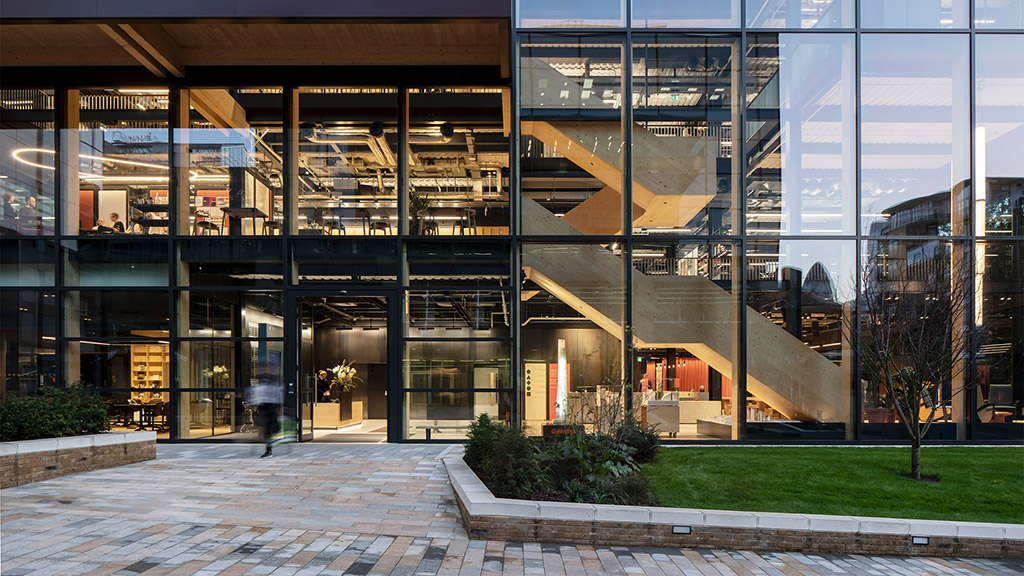What Does the Shift to a Hybrid Work Model Mean for Office Spaces in the U.K.?
November 05, 2020 | By Kerri Henderson, Jane Clay, and Julia Simet
The pandemic-induced, worldwide shift to remote work has left many offices sitting empty. Around the world and here in the U.K., we know that our work life has changed for good. Our latest nationwide, cross-industry survey of office workers set out to quantify that change, to learn more about what people expect to get out of their workplaces in the future, and to answer a common question from our clients: what does the model “future workplace” look like?
The 2020 U.K. Workplace Survey gathered data from the second week of July through the first week of August, reflecting people’s sentiments several months after the country entered lockdown in March and after the first peak of COVID-19 cases in April. We surveyed more than 2,500 U.K. workers across nine industries to produce a sample that covered a variety of roles and generations with a good balance of female and male respondents.
During that period, just over a quarter of our respondents were working from the office full time, another quarter were working in what we call a hybrid scenario — whereby they’re working from home for a portion of their week and working from the office a portion of the week — and just under half were working from home full time.
What we learned was two-fold: First, working from home supports peoples’ ability to focus and empowers them with the flexibility they need. Second, people still feel that the office is the best place to connect, collaborate, and socialize with others. When we asked workers to share their ideal situation moving forward, four out of five workers want to return to working in the office for at least part of their week. A strong two-thirds, 67% said that they’d like to work in a hybrid arrangement. Only 12% said that they would like to work from home full time — and that response aligns exactly with what we found in our U.S. Work From Home Survey conducted earlier in the pandemic.
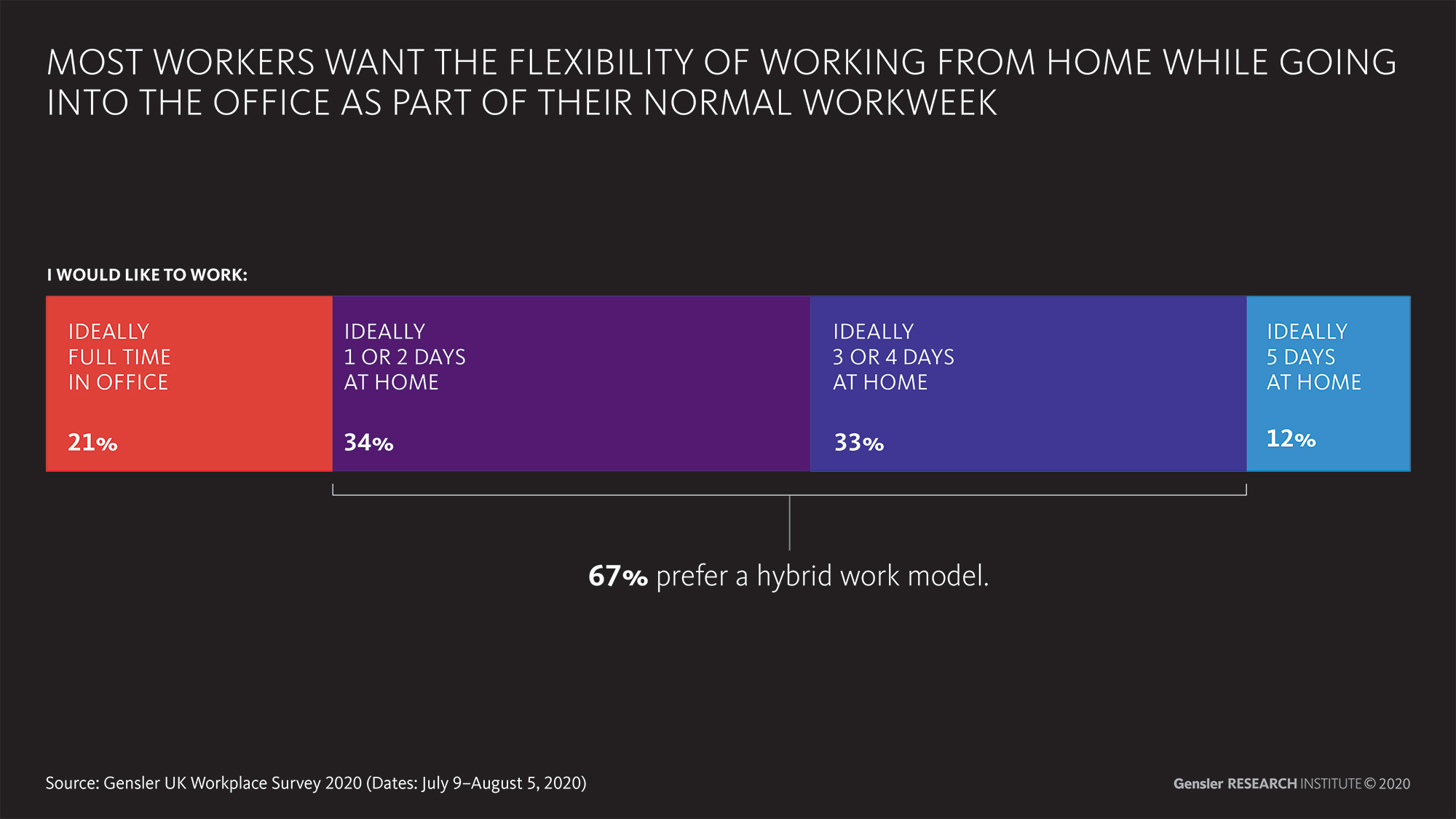
Survey respondents answered that a hybrid arrangement provides a greater work-life balance and supports their productivity while also providing social stimulation and connection. Respondents also reported that working from home part of the week helps them mentally.
This new hybrid reality will inevitably have implications for the office spaces themselves. How does the office need to change in order to meet these new needs and patterns of work?
Benefits of a hybrid work modelLooking at those respondents who are already working in a hybrid work model, we found that they feel more energized, accomplished, and appreciated than those who are either working from the office or working from home full-time. We also found that those working in a hybrid model are more likely to feel empowered, creative and satisfied in their job. One foundational characteristic of a hybrid work model is greater choice and agency for the worker in where and when they work. And it’s that variety and flexibility that we believe is really empowering for them.
Regardless of family situation — whether they live with other adults, children, infants and toddlers, or are living independently — most people want a hybrid model, even if their reasons for it differ. It could be that if you have young children, it may be harder to focus on independent work at home and you’re looking to do that focus work at the office. Those living alone could be craving the social interaction of the office to break up the monotony of working from home.
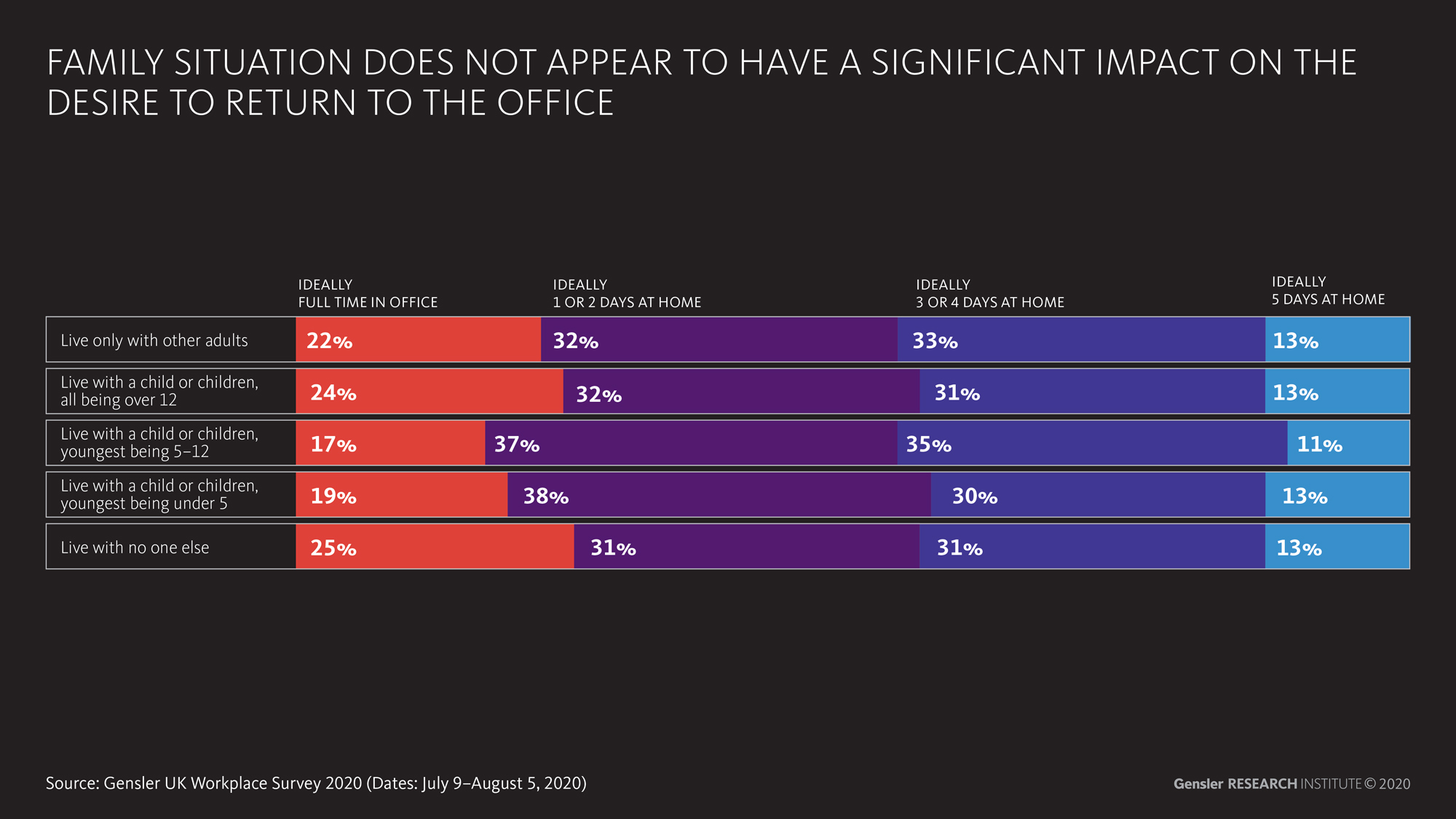
The design of the office needs to change
Flexibility isn’t optional anymore — it’s a must. People have proven the ability to be productive while working from home. But how do we leverage the physical office as a place for culture, connection, community-building, and innovation while still allowing for that flexibility?
The first step is to shift away from workplace density as the key metric for an office space’s long-term value. When we design for connection and communication, then people’s individual experiences in the workplace — whether they find value in the time they spend there — becomes the most important measure of success.
The onus is on designers to understand how individual teams work in order to appropriately design the workspace for them. In the pre-design stages, designers and strategists will need to understand the work cycle for each office or company in order to design the most effective and efficient space. Based on our research, here are six strategies and considerations that will shape the future workplace:
1. The office should remain mostly openDespite concerns about the pandemic, most U.K. workers we surveyed, 71%, would like to go back to an office that is mostly open. Through our research over the years, we have found that mostly-open environments with on-demand privacy — like phone rooms or focus rooms — are most desired by employees and return the highest effectiveness and satisfaction ratings.
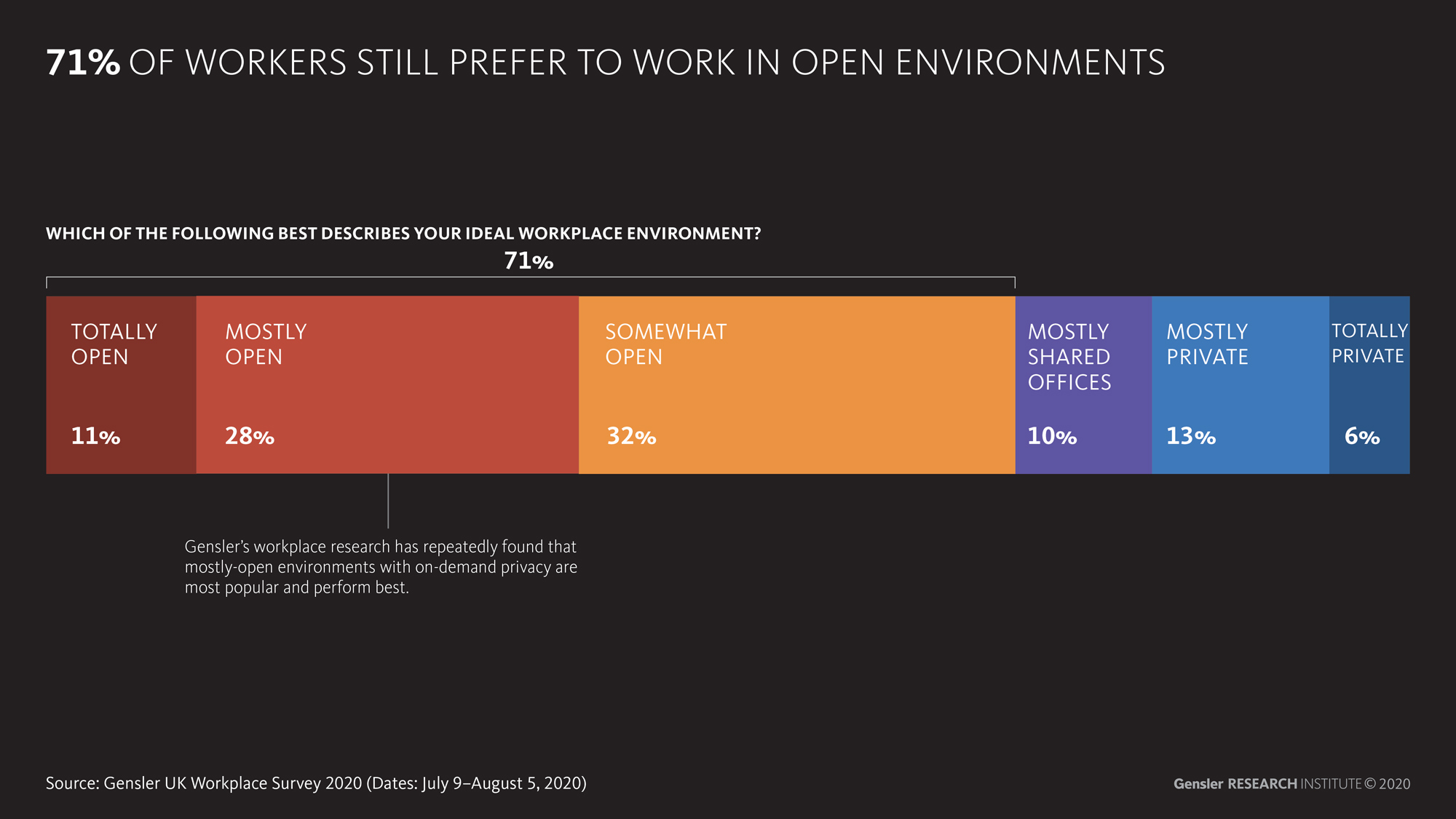
The next step is to deliver an open office that also supports increased video conferencing that will help connect distributed teams. Most spaces will need to be enabled for video conference, taking into account factors such as acoustics, degree of enclosure, background sightlines, technology, and more. Culturally, there will be a need to overhaul to the protocols and etiquette around how we use these spaces. With video conferencing potentially occurring not just in meeting rooms, but in semi-enclosed and open spaces as well, the office may feel buzzier than before.
3. Shift from workstations to collaborative spacesWith fewer workers typically on-site in the future, the balance of spaces at the office will need to shift to meet worker’s needs. Allocating fewer workstations to individuals frees up space that can be repurposed for a wider variety of collaborative spaces. Shared collaborative spaces should be designed to serve multiple functions like supporting individual work or merging with social spaces. Reducing workstations can be a key factor to enabling overall SF/SQM real estate savings, but it’s important to provide the spaces workers will need in the office, as well as planning for peak occupancy days.
At the same time, companies and organisations can’t eliminate workstations entirely. Our survey found space to focus on independent focus work is still the #3 reason U.K. workers want to come into the office. This may apply to people living with family members or young children, people who flat share, or anyone who doesn’t feel that they have a proper space in their home they can dedicate as their workspace. To support equity for employees, some spaces for individual focus work should be included in offices going forward.
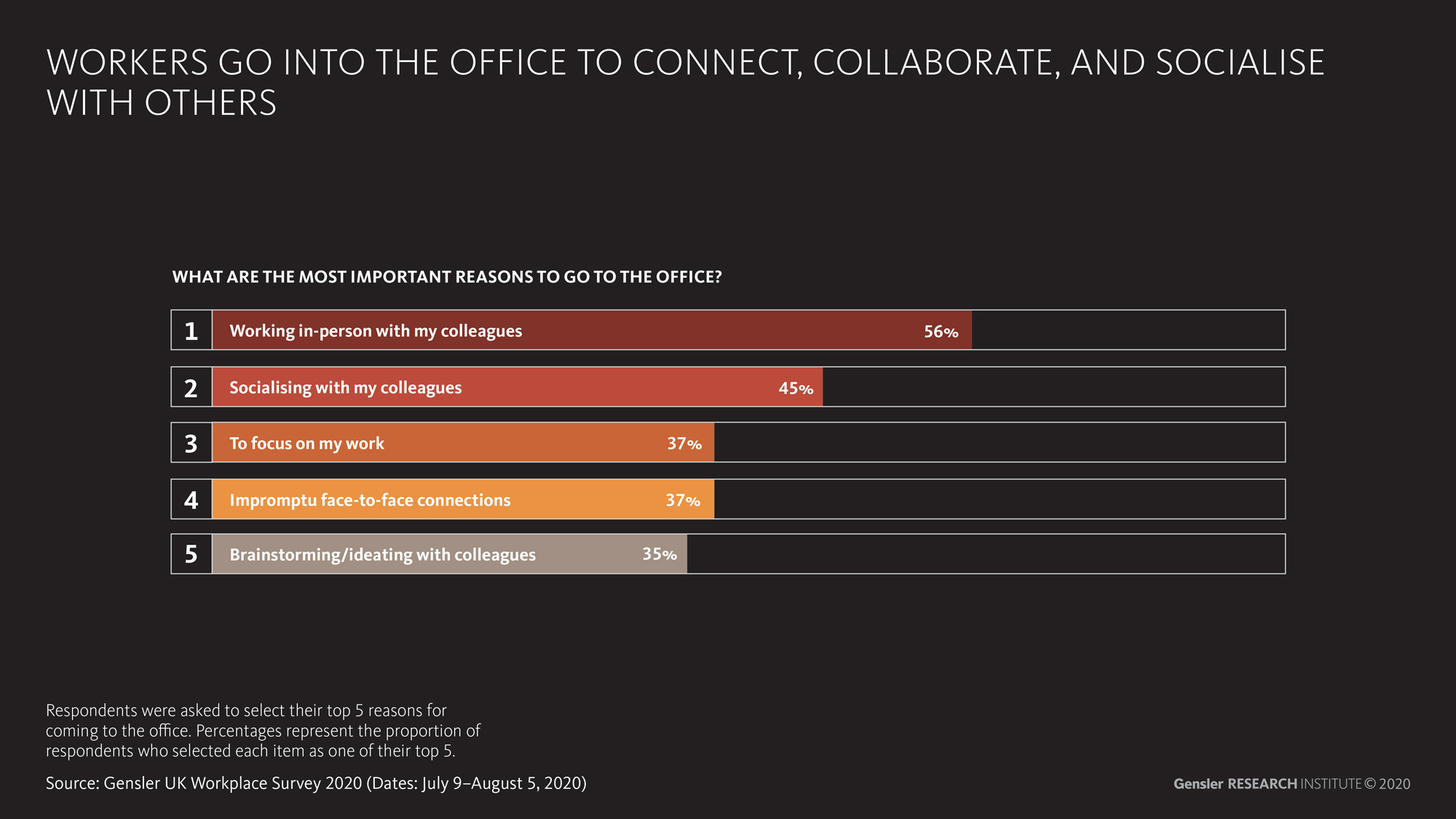
If you’re considering a shift to more unassigned seating, people’s preferences can be complicated. In our survey we found that most people’s preference leaned towards having an assigned desk — only 17% were willing to share. This is perhaps unsurprising given the current health crisis — but when you offer the opportunity to work in a more hybrid way, just over half of workers (51%) would be willing to trade their assigned desk for greater flexibility to choose when and where they work.
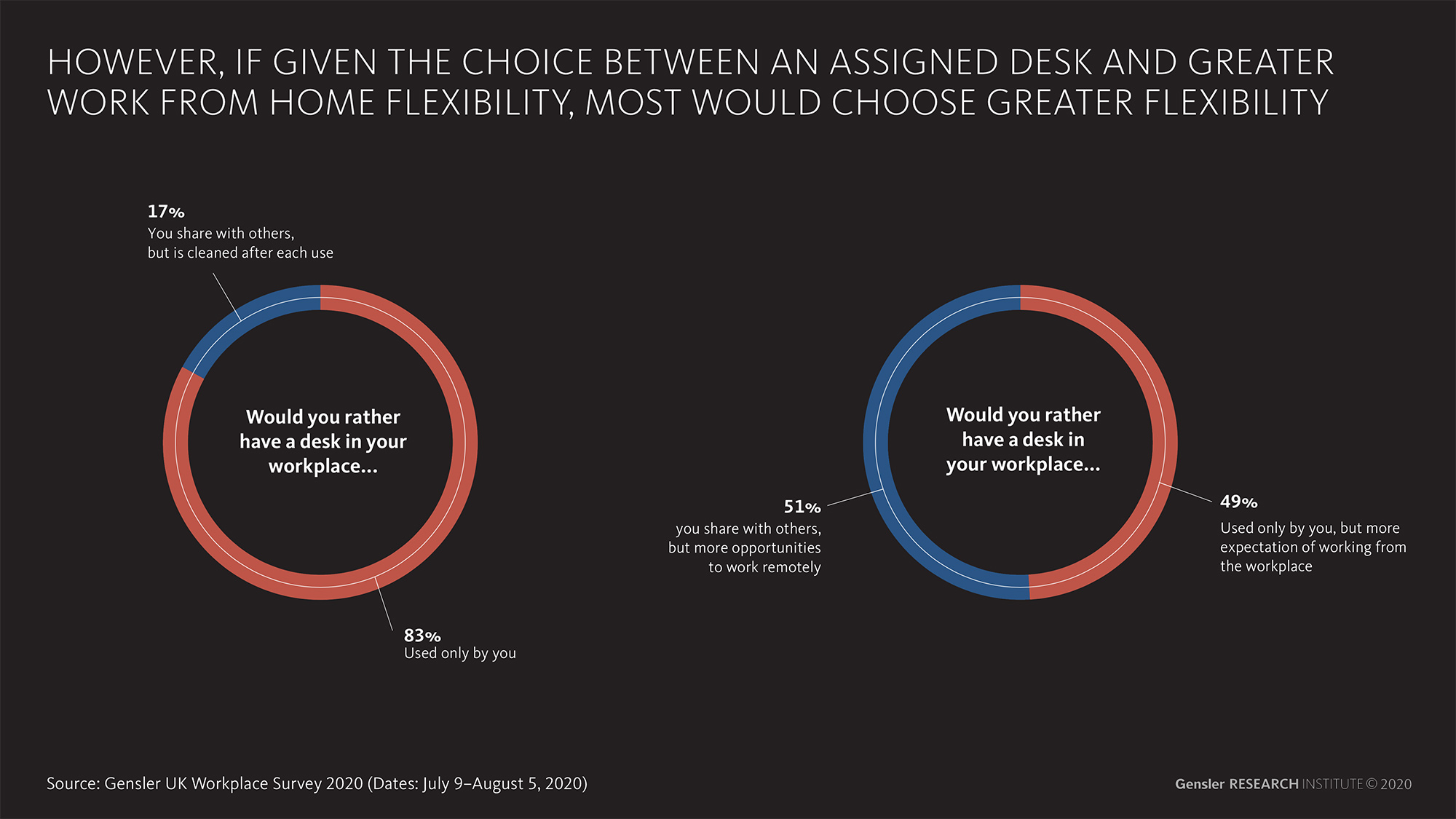
Greater flexibility presents another problem: if everybody can choose when and where they work, then teams are no longer fixed to a location or schedule. Understanding how in-office attendance may shift over the course of the week is important to designing a high-performing workplace. (by this I mean not only effective and efficient, but also one that connects people, doesn’t feel too empty) Practically for teams, the hybrid workplace may present an additional effort of organising times to be in the office together. In the future, in-office presence may be more driven by the team dynamic and meeting needs than by the organisation overall.
6. Create space for culture, mentoring, and connectionAwareness of what others are working on outside one’s own team is particularly important to building and maintaining company culture in a more remote work environment. For example, through our research we learned that less than half of U.K. workers participated in coaching or mentoring sessions during the pandemic — but those who did were disproportionately in executive, senior leadership or managerial roles.
Over video conferencing, it’s more difficult to see when team members are struggling and more difficult to discern how to best support them. And without in-person interaction informal meetings, walks, or coffee chats aren’t happening in the same way. Having a physical space to connect in-person and develop team and mentoring relationships is important not only to individual growth but also to an organisation’s long-term culture.
Ultimately, what we’re seeing is an acceleration of a trend that we’ve identified in our workplace research over the last decade: increased choice and variety correlates to employee satisfaction and workplace effectiveness. For years, people already working in a hybrid arrangement have reported the highest satisfaction with their work situation.
Now, with the pandemic, many more workers have gained the experience of working from home — and our latest survey results show that people’s expectations are changing to match. The next step will be creating a workplace that effectively meets their needs while allowing them to get the most value out of their time spent there.
For media inquiries, email .
